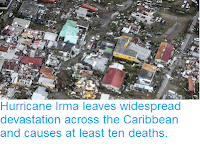Fifty nine people have now been confirmed dead and a further thirty three are still missing after Hurricane Maria swept across the Caribbean this week. The hurricane hit the island of Dominica at about 9.35 pm local time on Monday 18 September 2017 as a Category Five tropical storm when it hit the Leeward Islands, with
sustained winds in excess of 250 km per hour and gusts considerably
stronger. The storm is known to have killed 27 people here, with another 27 still missing, and caused widespread devastation, with widespread flooding and many of the island's buildings destroyed.
Damage in Roseau, Dominica, following the passage of Hurricane Maria. Cetus News.
The storm passed to the southwest of the Leeward Islands, but still caused widespread problems there. The island of Guadeloupe was hit by winds in excess of 160 kilometres per hour and waves over six meters high, which led to two fatalities from a fishing boat off the island and widespread damage to buildings and farmland. The storm was also felt in the Lesser Antilles, with the island of Martinique hit by a storm surge, high winds and rains, which have caused extensive damage to crops and buildings and injured two people.
Flooding on Guadeloupe on 19 September 2017, following the passage of Hurricane Maria. Frank Phazian/AP.
The storm hit Puerto Rico as a Category Four storm, with winds in excess of 210 km per hour and larger gusts. The storm caused widespread flooding on the island, including damage to a number of dams. Several coastal communities have been totally or nearly totally destroyed, and at least 24 people have died, with three people still missing on the island.
Damage to the Guajataca Dam in Puerto Rico, following the passage of Hurricane Maria. Alvin Baez/Reuters.
The storm passed to the northeast of the Dominican Republic, causing flooding and landslides that killed two people and destroyed around 110 homes. In neighbouring Haiti a further three people were killed. The Storm passed across the island of Saint Croix in the US Virgin islands,causing flooding and damage to buildings, and resulting in one fatality (due to a heart attack).
Flooding in the Dominican Republic on 20 September 2017. Erika Santlices/AFP/Getty Images.
Tropical storms are caused by the warming effect of the Sun over
tropical seas. As the air warms it expands, causing a drop in air
pressure, and rises, causing air from outside the area to rush in to
replace it. If this happens over a sufficiently wide area then the
inrushing winds will be affected by centrifugal forces caused by the
Earth's rotation (the Coriolis effect). This means that winds will be
deflected clockwise in the northern hemisphere and anti-clockwise in the
southern hemisphere, eventually creating a large, rotating Tropical
Storm. They have different names in different parts of the world, with
those in the northwest Atlantic being referred to as hurricanes.
The path and strength of Hurricane Irma. Thick line indicates the
past path of the storm (till 9.00 pm GMT on Tuesday 26 September 2017),
while the thin line indicates the predicted future path of the storm,
and the dotted circles the margin of error at six and twelve hours
ahead. Colour indicated the severity of the storm. Tropical Storm Risk.
Despite the obvious danger of winds of this speed, which can physically
blow people, and other large objects, away as well as damaging buildings
and uprooting trees, the real danger from these storms comes from the
flooding they bring. Each drop millibar drop in air-pressure leads to an
approximate 1 cm rise in sea level, with big tropical storms capable of
causing a storm surge of several meters. This is always accompanied by
heavy rainfall, since warm air over the ocean leads to evaporation of
sea water, which is then carried with the storm. These combined often
lead to catastrophic flooding in areas hit by tropical storms.
See also...
Follow Sciency Thoughts on Facebook.











